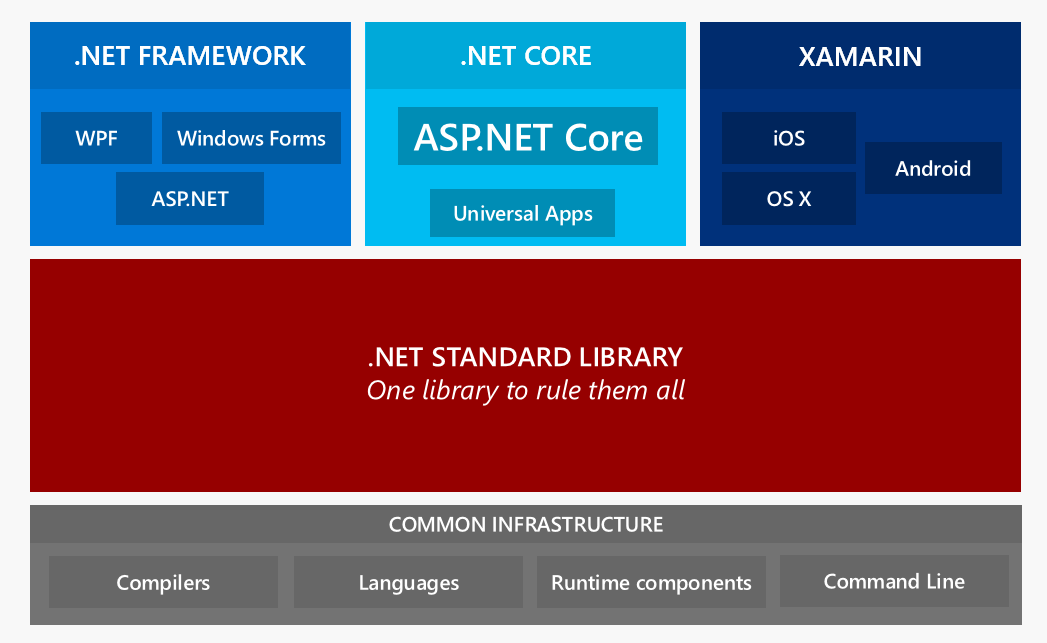.NET Core: The Big Picture

The .NET ecosystem has evolved significantly since 2016 when .NET Core 1.0 was released. Initially introduced as a lean, modular, and cross-platform subset of the full .NET Framework, .NET Core has matured into a robust platform for building a wide range of applications.
A Unified Platform
As of .NET 5 and its successor, .NET 6, the platform unifies the .NET ecosystem, bringing together the best of .NET Core, .NET Framework, Xamarin, and Mono into a single framework. This unified platform is simply called “.NET”, marking a significant shift away from the separate entities of .NET Core and the full .NET Framework.
Cross-Platform and Open Source
.NET (formerly .NET Core) retains its cross-platform capabilities, running seamlessly on Windows, Linux, and macOS. As an open-source framework, it continues to benefit from community contributions, with its source code accessible on GitHub.
Modular Design
The modular nature remains a key feature, allowing developers to include only the necessary packages via NuGet. This approach ensures applications are lightweight, with minimal dependencies.
.NET Standard
The .NET Standard, a set of APIs guaranteed to be available on all .NET implementations, has played a crucial role in this unification. It provides a consistent base for building libraries that work across all .NET flavors, enhancing code sharing and compatibility.
ASP.NET Core, the web development framework within the .NET ecosystem, has also seen significant updates. It remains a versatile framework for building web apps, APIs, microservices, and real-time applications using SignalR.
Target Frameworks
With the advancements in .NET, ASP.NET Core apps can target the unified .NET platform, benefiting from improvements in performance, security, and development capabilities.
Blazor for Web UI
A notable addition to ASP.NET Core is Blazor, a framework for building interactive client-side web UIs using C# instead of JavaScript. Blazor can run in the browser via WebAssembly or on the server, offering flexibility in how web applications are architected.
Continued Focus on Performance and Security
ASP.NET Core emphasizes performance and security. Its lightweight, modular nature ensures that applications are fast and resource-efficient, while built-in features like Identity Server and GDPR compliance tools make it easier to build secure web applications.
2016 (legacy info)
The new .NET Core is a modular verion of the full .NET Framework. Microsoft designed .NET Core to be portable across multiple platform in order to maximize code sharing and code re-use. It’s a subset of the full .NET Framework that provides key functionalities to create the application we want and be able to reuse that app’s code wherever, regardless of platform.
Our choice of platform makes no difference as .NET Core features are universal across all of them. For web apps, we could choose Windows, Linux or MacOS. Non-web app platforms include desktops, mobile and other devices.
.NET Core is called modular because it’s divided into many small specialized assemblies on Nuget as opposed to a single massive assembly with the full .NET Framework. This allows us to individually select the packages we want to incorporate in our app while bypassing everything else. Our app’s size is kept to a minimum this way.
Finally, .NET Core implements the new .NET Standard. The purpose of .NET Standard is to have an official agreement of .NET apis that are available across all platforms of .NET. It’s essentially one giant library to rule them all. Code sharing between multiple .NET platforms becomes easier for those platforms that implement this standard. The old way of using Portable Class Libraries jumping from platform to platform should fade.
ASP.NET Core
ASP.NET Core is an open-source, cross-platform framework for building modern, cloud-based internet connected applications. In addition to web apps, this framework can be used for mobile apps and Internet-Of-Things apps as well.
Being open-souce, we can peruse ASP.NET Core’s source code at github.com/aspnet and freely contribute to that project.
ASP.NET Core is cross-platform so we can write our apps on Windows, MacOS or Linux. A variety of IDEs and text editors are available are on those platforms from the ever reliable Visual Studio to Visual Studio Code to Project Rider by JetBrains.
Microsoft created ASP.NET Core from scratch. It’s not an update to ASP.NET 4 as that framework was based on the System.Web namespace, which meant having many excess functionalities. The Core team decided to forgo big and bulky for granular and lean. As with .NET Core, ASP.NET Core is also based on modular Nuget packages. We only import the packages we need for our app. Less excess results in tighter security, reduced maintenance and improved performance.
Frameworks
ASP.NET Core apps can target either the full .NET Framework or .NET Core. If we choose full .NET then we’ll have all the dependencies we’re used to having. Since .NET Core is newer, not all the assemblies are available yet. There’s the possibility that .NET Core will never port over certain assemblies. However, if the app wants to maximize modularity, have a small memory footprint and be cross-platform then nothing beats targeting .NET Core. Unless we utilize .NET features to it’s fullest, ASP.NET Core apps should choose .NET Core as their framework.